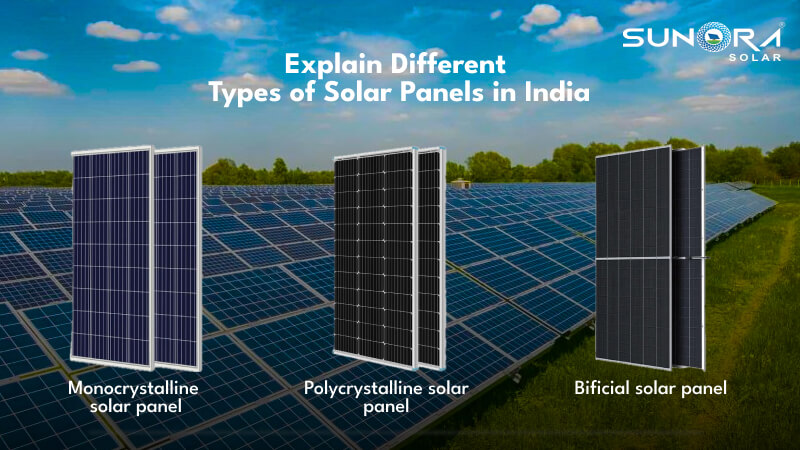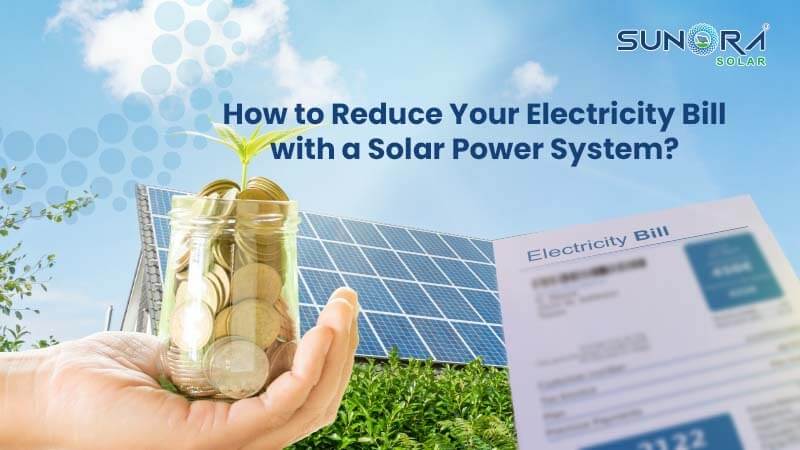India is rapidly adopting solar panels due to their efficiency and bill savings. However, many types of solar panels are available in the Indian market. So, which one is the best type of solar panel in India? The choice can be confusing, especially when many have high efficiency and performance. So, we created this list of different types of solar panels in India and their specifics to help you make a better decision.
Whether you are looking for home or commercial solar panels, understanding the different types can help you choose the best solar panel for your budget.
The solar panel can be differentiated based on two factors:
- The structure of the cells of the solar panels
- The technology used to create the solar panels
Let’s understand both of these solar panel types.
Types of Solar Panels Based on Their Structure
The structure of the solar panel refers to the type and arrangement of the solar cells. This is one of the most common differences between the types of solar panels in India.
Monocrystalline solar panel
In a monocrystalline solar panel, the PV cell is made of a single silicon crystal. Therefore, it has a sleek black appearance.
- Efficiency: 20-25%
- Lifespan: 25-30 years
- Higher temperature tolerance
The monocrystalline solar panels are perfect for small projects requiring higher energy production. While they are costly, the energy output reduces the payback time significantly. If you want better ROI or have a small space, these solar panels perfectly fit you.
Polycrystalline solar panel
In a polycrystalline solar panel, the PV cell is made using fragments of the silicon crystal. They have a blue tint due to their mixed quality. They are a pocket-friendly option in the market.
- Efficiency: 14-18%
- Lifespan: 20-25 years
- Lower temperature tolerance
The polycrystalline solar panels are known to have low efficiency. Therefore, despite its lower cost, the payback period might be longer. Also, you might need more space to meet your energy requirements. If you have space but want budget-friendly solar, you can use polycrystalline solar.
Thin-film solar panel
Thin-film solar panels are an innovative solution popular because of their flexible design. It can be rolled or curved easily to fit on walls and curvy roof-tops with less space. They are often made with Amorphous Silicon (a-Si), Copper Indium Gallium Selenide (CIGS), or Cadmium Telluride (CdTe).
- Efficiency: 14-18%
- Lifespan: 20-25 years
- Lower temperature coefficient
Due to their light weight and flexibility, they are perfect for those who need adjustable solar panels within their budget.
Bificial solar panel
In traditional solar panel designs, the PV cells are only on one side of the sheet. This leaves the other side underutilized. In bifacial solar panels, the other side of the sheet has solar cells on both sides. They are installed on a reflective surface at a tilted angle to increase sunlight exposure on both sides.
- Efficiency: 25-30% on a peak sunny day
- Lifespan: depends on the solar cell used
If you have a reflective surface or a small space and want the best ROI from your solar panels, the Bifacial type will work best for you. Monocrystalline bifocal solar panels are among the best designs due to their better efficiency, temperature coefficient, and durability.
Half-cut solar panel
In a half-cut solar panel, the original solar cell is cut in half to increase the number of cells in the same-sized panel. It is designed to create two separate energy-producing units. Thus, if one unit has a problem, the other remains unaffected.
- Efficiency: depends on the solar cell used
- Lifespan: depends on the solar cell used
Monocrystalline solar cells are the best for half-cut solar panels.
Types of Solar Panels Based on Their Technology
Let’s understand different types of solar panels in India based on the technology used to create them.
PERC solar panels
PERC or Passive Emitted and Rear Cell solar panels have an additional layer at the bottom of the solar panel. It reflects the sunlight on the solar cells to generate more electricity. The efficiency of the PERC solar panel depends on the solar cells. Mono PERC solar panels are one of the best solar panels due to their higher efficiency and quick ROI.
TOPCon solar panel
TOPCon or Tunnel Oxide Passivated Contact technology includes adding a passivated layer on the top and bottom of the solar cells. It reduces energy loss and increases sunlight exposure in the cells to boost efficiency. The TOPCon bifacial monocrystalline solar panel is the best choice for efficiency, longevity, and better ROI!
HJT solar panel
HJT or Heterojunction Technology solar panels are a new design using silicon wafers and amorphous silicon layers to create a hybrid model. It is gaining popularity because its efficiency often reaches beyond 25%. It costs more because it requires a new production line, and many Indian solar panel manufacturers have yet to adopt it.
Concentrating photovoltaic (CPV) solar panels
The Concentrating photovoltaic (CPV) solar panels are similar to traditional solar panels but have concave mirrors and convex lenses above the solar cells. This results in concentrated sunlight exposure for better efficiency. CPV solar panels can have an efficiency of almost 38%.
Conclusion
Different types of solar panels are based on their cell structure and the technology used to create them. Monocrystalline and polycrystalline solar panels are the primary types of solar cells used to create other types of solar panels in India, such as thin-film, bifacial, and half-cut. PERC and TOPCon are other popular technologies used to increase the efficiency of the traditional solar panel. Mono PERC and TOPCon bifacial monocrystalline solar panels are the best solar panel designs. You can also find HJT and CPV solar panels for efficiency. Contact Sunora Solar for expert advice on choosing the best solar panel that fits your space and budget.
FAQ
What are the types of solar panels in India?
The following are a few popular types of solar panels:
- Monocrystalline solar panels for higher efficiency in a small space
- Polycrystalline solar panels are a budget-friendly option for people with large spaces
- Thin-film solar panels are flexible and lightweight to fit anywhere
- Bifacial solar panels to maximize sunlight exposure and efficiency
- Half-cut solar panels to ensure that solar panels are not dependent on each other when a malfunction happens
- PERC solar panels to increase sunlight exposure
- TOPCon solar panels to reduce energy loss
Which is better: TOPCon or Bifacial solar panels?
While bifacial solar panels have more solar cells, the TOPCon solar panels have an extra layer to increase the sunlight exposure on the single layer itself. You can get the best of two solar types by using Sunora Solar’s TOPCon Bifacial Monocrystalline solar panel.
How to choose the right solar panel for me?
When choosing the solar panels, focus on your energy needs, available space, and the budget. Choose a solar panel that will meet your energy requirements and fit the space. You can get government subsidies to cover the cost. Contact Sunora Solar to get guidance on solar subsidies and more.
Which type of solar panel is most efficient?
Monocrystalline solar panels have the best efficiency. Therefore, you can choose bifacial, half-cut, PERC, and TOPCon monocrystalline solar cells for the best efficiency. Contact Sunora Solar to know which one is suitable for your needs.




